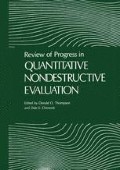Abstract
This work is motivated by the need for realistic ultrasonic probability of detection (POD) models in nondestructive evaluation (NDE). Past POD models have utilized flaw farfield scattering amplitudes along with other system parameters to predict the expected signal in postulated measurement geometries [1]. However, numerical evaluations of scattering amplitudes have generally been restricted to idealized flaw shapes and, to our knowledge, no scheme to calculate scattering amplitudes of arbitrary shape has ever been implemented in 3D. Volumetric shapes with an axis of symmetry have been examined with T-matrix and MOOT [2,3] but the axisyrametric limitation precludes a large portion of all expected flaw shapes. Furthermore, a quasi-plane wave assumption is often made. This assumption can become inappropriate for critical flaw sizes on the order of the beam size. A truly general POD model needs to have these assumptions removed.
Access this chapter
Tax calculation will be finalised at checkout
Purchases are for personal use only
Preview
Unable to display preview. Download preview PDF.
References
T. A. Gray and R. B. Thompson, in Review of Progress in Quantitative NDE. edited by D. O. Thompson and D. E. Chimenti (Plenum Press, New York, 1986), Vol. 5A, pp. 911–918
V. K. Varadan and V. V. Varadan, J. Acoust. Soc. Am. 65(4), 1979, pp. 896–995
J. L. Opsal and W. M. Visscher, J. Appl. Phvs. 58(3), 1985, pp. 1102–1115
F. J. Rizzo, D. J. Shippy and M. Rezayat, Int. J. Numer. Methods Eng. 21, 1985, pp. 115–129
M. Rezayat, F. J. Rizzo, and D. J. Shippy, Comp. Meth. Appi. Mech. Vol. 55, 1986, pp. 173–179
R. B. Thompson and E. F. Lopes, in Review of Progress in Quantitative NDE. edited by D. O. Thompson and D. E. Chimenti (Plenum Press, New York, 1986), Vol. 5A, pp. 117–125
B. R. Tittman, in Proceedings of the ARPA/AFML Review of Progress in Quantitative NDE. AFML-TR-77–44, 1977, pp. 173–179
G. D. Manolis, Int. J. Numer. Methods Eng. 19, 1983, pp. 73–91
B. A. Auld, Wave Motion 1, 1979, pp. 3–10
Author information
Authors and Affiliations
Editor information
Editors and Affiliations
Rights and permissions
Copyright information
© 1989 Springer Science+Business Media New York
About this chapter
Cite this chapter
Schafbuch, P.J., Thompson, R.B., Rizzo, F.J., Rudolphi, T.J. (1989). Elastic Wave Scattering by Arbitrarily Shaped Voids. In: Thompson, D.O., Chimenti, D.E. (eds) Review of Progress in Quantitative Nondestructive Evaluation. Springer, Boston, MA. https://doi.org/10.1007/978-1-4613-0817-1_2
Download citation
DOI: https://doi.org/10.1007/978-1-4613-0817-1_2
Publisher Name: Springer, Boston, MA
Print ISBN: 978-1-4612-8097-2
Online ISBN: 978-1-4613-0817-1
eBook Packages: Springer Book Archive

